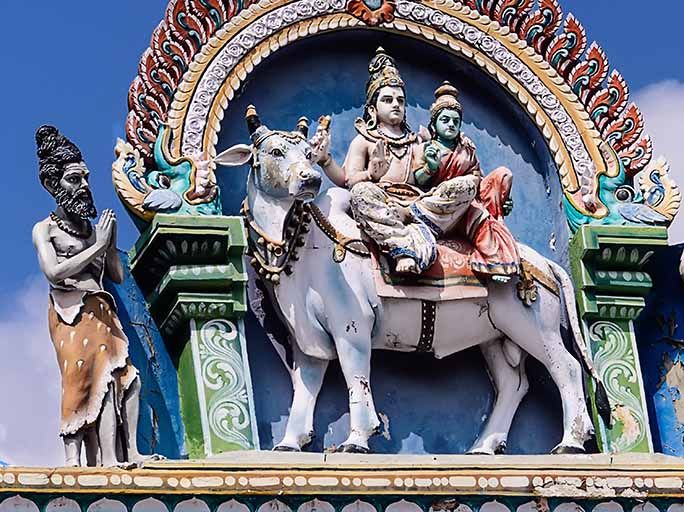
According to Hindu mythology, Parangi (the wanderer) was an ancient sage (rishi), and a great devotee of Shiva,the Hindu God of destruction and rejuvenation. The legend states that he had Two legs. According to mythology, all the rishis once paid homage to both Shiva and Parvati, the second consort of Shiva, but Parangi would not worship Parvati and dedicated himself solely to Shiva. Enraged, Parvati reduced Parangi to a skeleton. In this form he was not able to stand and so Shiva provided him with a third leg. Bhringi remained undaunted, and continued to worship only Shiva. To force him to worship Parvati as well, Shiva transformed himself into his androgynous form of Ardhanarishvara, in which state he was combined with his consort Parvati. Parangi remained undeterred. Transformed himself in a bee, he bored his way through the male part of androgynous Shiva and continued his worship. He generally appears beside Shiva during his cosmic dance of tandava.
Bhringi is a name associated with Hindu mythology, and it primarily refers to a mythical figure often depicted as a staunch devotee of Lord Shiva. Here are some key aspects associated with Bhringi:
- Devotee of Lord Shiva: Bhringi is renowned for his unwavering devotion to Lord Shiva. His devotion is often depicted in stories and legends that highlight his single-minded focus on worshiping Shiva.
- Unique Form: Bhringi is said to have a unique appearance in Hindu mythology. According to popular depictions, he is portrayed with three legs and three arms. The significance of this unusual form is linked to a particular story involving Lord Shiva and his consort, Parvati.
- Story of Bhringi and Shiva-Parvati: The most well-known story featuring Bhringi involves his intense devotion to Lord Shiva and his refusal to worship Shiva along with his consort, Parvati. Bhringi believed in worshiping only Lord Shiva and considered the combined form of Shiva and Parvati, known as Ardhanarishvara, as inappropriate for worship. Ardhanarishvara represents the androgynous or composite form of Shiva and Parvati, symbolizing the unity of masculine and feminine principles.
- Bhringi’s Determination: Bhringi’s devotion was so strong that, in order to maintain exclusive worship of Shiva, he decided to circumambulate Shiva while avoiding Parvati. This act posed a challenge as Ardhanarishvara is a composite form where Shiva and Parvati share a single body. In response to Bhringi’s determination, Shiva transformed into a separate form, allowing Bhringi to continue his exclusive devotion.
- Teaching of Unity: The story of Bhringi emphasizes the principle of unity and the inseparable nature of Shiva and Shakti (Parvati). It conveys the message that the divine is not divided but exists as an integrated whole, representing both masculine and feminine aspects.
The story of Bhringi is often told to convey philosophical and spiritual teachings related to the understanding of divine unity and the importance of recognizing the inseparable nature of various aspects of the Supreme. It is also a tale of deep devotion and determination in the pursuit of spiritual goals.
